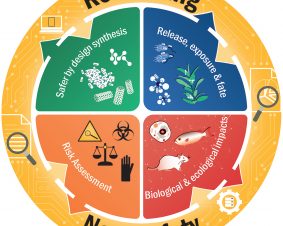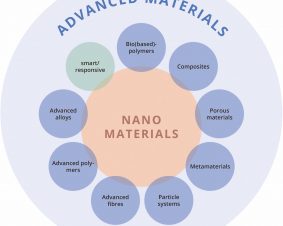 >
Spotlight November 2021: Safe Materials from Scratch – Safe-by-Design in Materials Research
>
Spotlight November 2021: Safe Materials from Scratch – Safe-by-Design in Materials Research
Advances in the field of materials science continue to amaze us with nanoscale materials with extraordinary chemical, electrical, optical, and numerous other properties. However, some nanoscale materials have different toxicological profiles compared to the same bulk material. Since safety issues are usually addressed just before launching a product into the market, safety issues may be discovered too late, thus resulting in a lot of wasted effort. This month we want to highlight a two-part research paper. This paper proposes a Safe-by-Design (SbD) strategy to link materials functionality with environmental and human safety allowing innovators to anticipate potential safety issues in the early stages of the innovation process. Therefore, unleashing the full economic potential of innovative nanoscale materials.
The SbD strategy aims to reduce uncertainties in materials research and development and, at the same time, raise human and environmental safety. The proposed strategy ensures the collection of safety-related data throughout the whole development process complying with regulatory requirements and ensuring a transparent communication of risks from early in the innovation process onwards. The authors adapt the Cooper’s stage-gate-model – a project management technique usually used for product development – by including new decisive parameters for the decision-making during the innovation process. Moreover, the authors offer a comprehensive overview of the information needed to balance safety and functionality and illustrate the applicability of the SbD strategy using a case study: Carbon nanotube-based transparent conductive films. Whereas the second part of the paper concentrates on the applicability of SbD, the first part offers a set of questions to identify which type of information is required to assess and reduce environmental and human risks. These questions allow innovators to find, prioritize, and choose safer alternatives.
Original publications:
Tavernaro, I., Dekkers, S., Soeteman-Hernández, L. G., Herbeck-Engel, P., Noorlander, C., and Kraegeloh, A. 2021. Safe-by-design part II: a strategy for balancing safety and functionality in the different stages of the innovation process. NanoImpact, 24, 100354. DOI: 10.1016/j.impact.2021.100354
Dekkers, S., Wijnhoven, S. W., Braakhuis, H. M., Soeteman-Hernandez, L. G., Sips, A. J., Tavernaro, I., Kraegeloh, A., and Noorlander, C. W. 2020. Safe-by-Design part I: Proposal for nanospecific human health safety aspects needed along the innovation process. NanoImpact, 18, 100227. DOI: 10.1016/j.impact.2020.100227
Weitere Spotlights
Spotlight July 2021: The Path to Digital Material Research – It is never too late to start
Machine Learning, Artificial Intelligence, Big Data…. Have you read these words lately? No, these are not just buzzwords. The digitalisation of science is an evolving topic that is gaining importance with each passing day. That is why this month we would like to introduce you to the article “Digital Transformation in Materials Science: A Paradigm […]
Read moreSpotlight July 2022: New definition on nanomaterials published
The European Union has published a new definition for nanomaterials as of June 2022. It is recommended that this be used as a basis for future legislation. The new documents can be found on the EC website. In the new “nanodefinition”, the essential components such as the origin or the size range of the particles […]
Read moreSpotlight Juli 2020: “Nanosafety – More than just regulatory processes”
Nanosafety is more than just a compulsory aspect of nanomaterials research and regulation. This research area also has great potential to drive new innovations. It is exactly this perspective that is addressed in the special issue “Rethinking Nanosafety: Harnessing Progress and Driving Innovation” by Chen et al. 2020. The article illustrates that especially in the field of […]
Read moreSpotlight June 2022: From small to clever – What does the future hold for the safety and sustainability of advanced materials?
The smallest particles in materials research, nanoparticles, have occupied us intensively for more than 20 years to elucidate and further investigate their safety for humans and the environment. Now, however, the development is going from “small = nano” to “clever = advanced”, as discussed in a contribution by international scientists. Thereby, it is a great […]
Read more


